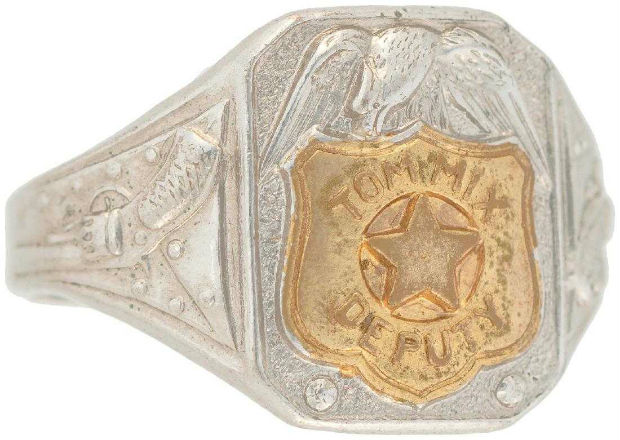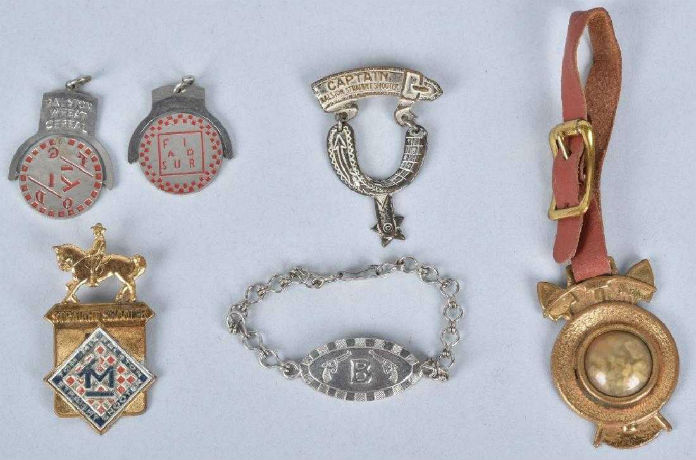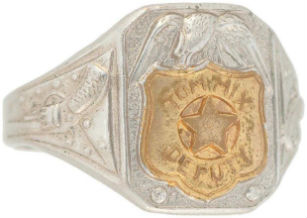
HAZLETON, Pa. (AP) – Anthony “Tony” Evangelista remembered sending for a souvenir from one of the radio programs he listened to in the 1940s. The ring from the Tom Mix Ralston Straight Shooters program set him back 10 cents and a label from Ralston instant farina.
And within a few days—a wait that seemed like forever for the then 10-year-old—he received it.
It was a ring, but not just any old ring. This was an official Tom Mix siren ring, and by blowing its whistle, listeners save the hero’s life.
“Radio really incorporated the kids. It made you a part of what was going on so you couldn’t wait to get those packages at home,” said Evangelista, who grew up in Hazleton and lives in Fleetwood.
Evangelista would eventually amass a collection of hundreds radio premiums that would be featured in the Smithsonian Institution, written about in The New York Times and shown on Good Morning America.
Looking back, the retired art professor said his family was poor. But the radio novelties could be obtained by sending in a proof of purchase from, say, a cereal box, along with a stamp and a small amount of cash.
“At the time, there were no toy stores. Kids for Christmas would get a shirt or a sweater. The only way to get a toy was if you sent for something over the radio,” he said. “You can’t imagine what it was like wanting to run home after school for a package.”
Evangelista became a faithful radio listener when he turned 8.
“They’d have the programs on every half hour. There was Superman followed by Tom Mix on weekdays. And on Saturdays, I’d listen to Jack Armstrong. They were ongoing episodes. I was an only child so listening to the radio was company,” he said.

The novelties made the programs even more enjoyable.
“What was nice about radio was that it included you into the programs,” he said. “Captain Midnight was on after school. You could send for a decoder. They’d work a message in to the program and with that decoder you could figure it out and you would know what was going to happen the next day.”
Wheaties cereal sponsored the radio adventure of Jack Armstrong—and Evangelista remembers sending box labels for prizes.
“Jack Armstrong was an all-American boy involved in athletics,” Evangelista explained.
The radio premiums, he recalled, included cereal bowls with the likenesses of popular athletes like Joe DiMaggio and pedometers that could be affixed to belts.
Captain Midnight was a patriotic show and so were its premiums. The Lone Ranger released an atomic bomb ring in the late 1940s that promised children that they would “see brilliant flashes of light in the inky darkness inside the (ring’s) atom chamber.” The advertisement for the ring noted that it was completely safe.
“I had maybe a dozen items,” Evangelista said. “When I went to college, I gave them to my cousin. Years later I started teaching jewelry at Wilkes College, and I thought about the (radio premium) rings with secret compartments, rings that lit up and rings that had compasses.”
He contacted his cousin, only to learn that the items had been discarded. Evangelista then decided that he’d like to build a collection.
From Wilkes, he began teaching art Kutztown University. When colleagues learned that he had an interest in radio premiums, they directed him to nearby antique shops and markets.
Soon he’d have dozens of items. Pins. Windup toys. Masks. Dolls. Rayguns.
He shared his collection with the Museum of Broadcasting in New York City in the late 1970s. A New York Times reporter saw the display and contacted him for an interview. New York magazine followed suit, and Time Life Publishing included his collection in its Encyclopedia of Collectibles.
Next came appearances on Good Morning America’ and the Tomorrow show with host Tom Snyder.
“One thing just led to another,” Evangelista said. “Then I got a phone call from a curator from the Smithsonian. He met with me and over the years we became friends. We went antiquing together.”
Another call came from a designer from a paper company. The collection was photographed and featured in promotional booklets sent to printers around the country. Not only that, but one of Evangelista’s Roy Rogers microscope rings was chosen for a scene in the Woody Allen movie, Radio Days.
Although he has hundreds of items, Evangelista has four favorites.
Two are Captain Midnight premiums—one a decoder and the other a ring with a secret compartment. Another is the atomic bomb ring.
“I also cherish the Tom Mix siren ring,” he said, referring to the first piece he ever owned.
___
By JILL WHALEN, The (Wilkes-Barre) Citizens’ Voice
Information from: The Citizens’ Voice, http://www.citizensvoice.com
Copyright 2018 Associated Press. All rights reserved. This material may not be published, broadcast, rewritten, or redistributed.
AP-WF-11-06-18 1817GMT


